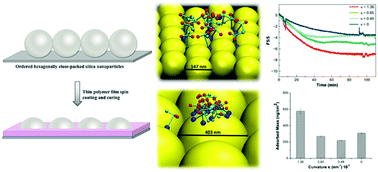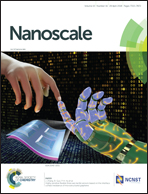Orienting proteins by nanostructured surfaces: evidence of a curvature-driven geometrical resonance
Abstract
Experimental and theoretical reports have shown that nanostructured surfaces have a dramatic effect on the amount of protein adsorbed and the conformational state and, in turn, on the performances of the related devices in tissue engineering strategies. Here we report an innovative method to prepare silica-based nanostructured surfaces with a reproducible, well-defined local curvature, consisting of ordered hexagonally packed arrays of curved hemispheres, from nanoparticles of different diameters (respectively 147 nm, 235 nm and 403 nm). The nanostructured surfaces have been made chemically homogeneous by partially embedding silica nanoparticles in poly(hydroxymethylsiloxane) films, further modified by means of UV-O3 treatments. This paper has been focused on the experimental and theoretical study of laminin, taken as a model protein, to study the nanocurvature effects on the protein configuration at nanostructured surfaces. A simple model, based on the interplay of electrostatic interactions between the charged terminal domains of laminin and the nanocurved charged surfaces, closely reproduces the experimental findings. In particular, the model suggests that nanocurvature drives the orientation of rigid proteins by means of a “geometrical resonance” effect, involving the matching of dimensions, charge distribution and spatial arrangement of both adsorbed molecules and adsorbent nanostructures. Overall, the results pave the way to unravel the nanostructured surface effects on the intra- and inter-molecular organization processes of proteins.



 Please wait while we load your content...
Please wait while we load your content...